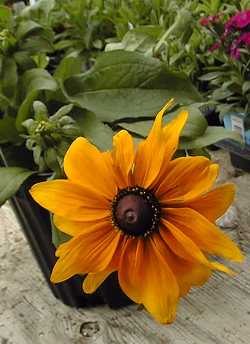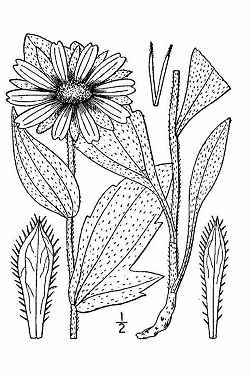Sunset®: All zones
USDA: 5-11
Frost Tolerance: Hardy in Phoenix
Heat Tolerance: Partial sun in summer in Phoenix, keep well watered
Sun Exposure: Full sun
Origin: Northern America
Growth Habits: Biennial, sometimes grown as annual, 3 feet tall (1 m)
Flowers: Yellow flowers
Watering Needs: Fairly drought tolerant, but they perform best with regular watering
Propagation: Seeds

Rudbeckia hirta 'Goldilocks'
Rudbeckia hirta, the black-eyed Susan, is a biennial forb about 3 feet tall (1 m) with yellow ray flowers and dark brown spherical centers. After germination, the seedling grows into a rosette with oblong leaves. Sometimes flower stalks will appear in the first summer, but typically black-eyed Susan blooms from June to September of the second year. After flowering and seed maturation, the plants die.
Black-eyed Susan is naturalized in most of the states east of Kansas and the bordering areas of Canada. It is adapted throughout the Northeast on soils with a drainage classification range from well-drained to somewhat poorly drained. It will perform acceptably on droughty soils during years with average or above rainfall, but best growth is achieved on sandy, well drained sites. It is winter hardy in areas where low temperatures are between -30 ° and -20 °F.

Rudbeckia brittonii, Britton, N.L., and A. Brown. 1913. Illustrated flora of the northern states and Canada. Vol. 3: 471.
Blooming Habits:
The Black-Eyed Susan blooms from July to October. Flowering is more profuse when the faded blossoms are removed. The flowers are useful for cutting.
Propagation:
The seed is very small (1,746,000 per pound) and black, about 2 mm long and 0.5 mm in diameter. Rudbeckia seed may be planted directly in place, but seeds started indoors germinate more quickly. The seed should be barely covered. They germinate in 5 to 10 days at 70 to 75° F (21 to 24° C).
Desert-Tropicals is dedicated to provide gardening advice, gardening ideas, and information about flower of all kind for landscape and collections.We try to check carefully the identification of the plants on the illustrations as well as the other information from the page, but occasionally errors do occur. if you notice anything that needs to be changed please contact us.Thanks.
© 1998-2020 Philippe Faucon, All Rights Reserved.
